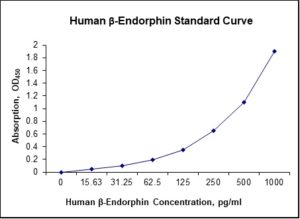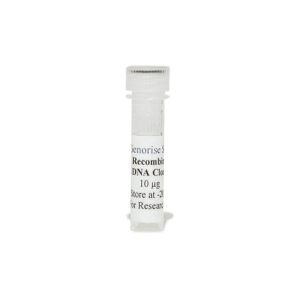Nori Human beta-Endophin ELISA Kit
$461.00 – $832.00
This ELISA kit is for quantification of b-endophin in human. This is a quick ELISA assay that reduces time to 50% compared to the conventional method, and the entire assay only takes 3 hours. This assay employs the quantitative sandwich enzyme immunoassay technique and uses biotin-streptavidin chemistry to improve the performance of the assays. An antibody specific for b-endophin has been pre-coated onto a microplate. Standards and samples are pipetted into the wells and any b-endophin present is bound by the immobilized antibody. After washing away any unbound substances, a detection antibody specific for b-endophin is added to the wells. Following wash to remove any unbound antibody reagent, a detection reagent is added. After intensive wash a substrate solution is added to the wells and color develops in proportion to the amount of b-endophin bound in the initial step. The color development is stopped, and the intensity of the color is measured.
Alternative names for b-endophin: Beta-endophin
This product is for laboratory research use only not for diagnostic and therapeutic purposes or any other purposes.
- Description
- How Elisa Works
- Product Citation ()
- Reviews (0)
Description
Nori Human beta-Endophin ELISA Kit Summary
Alternative names for b-endophin: Beta-Endophin
| Assay Type | Solid Phase Sandwich ELISA |
| Format | 96-well Microplate or 96-Well Strip Microplate |
| Method of Detection | Colorimetric |
| Number of Targets Detected | 1 |
| Target Antigen Accession Number | na |
| Assay Length | 3 hours |
| Quantitative/Semiquantitative | Quantitative |
| Sample Type | Plasma, Serum, Cell Culture, Urine, Cell/Tissue Lysates, Synovial Fluid, BAL, |
| Recommended Sample Dilution (Plasma/Serum) | No dilution for sample <ULOQ; sufficient dilution for samples >ULOQ |
| Sensitivity | 3 pg/mL |
| Detection Range | 15.6-1000 pg/mL |
| Specificity | Natural and recombinant human b-endophin |
| Cross-Reactivity | < 0.5% cross-reactivity observed with available related molecules, < 50% cross-species reactivity observed with species tested. |
| Interference | No significant interference observed with available related molecules |
| Storage/Stability | 4 ºC for up to 6 months |
| Usage | For Laboratory Research Use Only. Not for diagnostic or therapeutic use. |
| Additional Notes | The kit allows for use in multiple experiments. |
Standard Curve
Kit Components
1. Pre-coated 96-well Microplate
2. Biotinylated Detection Antibody
3. Streptavidin-HRP Conjugate
4. Lyophilized Standards
5. TMB One-Step Substrate
6. Stop Solution
7. 20 x PBS
8. Assay Buffer
Other Materials Required but not Provided:
1. Microplate Reader capable of measuring absorption at 450 nm
2. Log-log graph paper or computer and software for ELISA data analysis
3. Precision pipettes (1-1000 µl)
4. Multi-channel pipettes (300 µl)
5. Distilled or deionized water
Protocol Outline
1. Prepare all reagents, samples and standards as instructed in the datasheet.
2. Add 100 µl of Standard or samples to each well and incubate 1 h at RT.
3. Add 100 µl of Working Detection Antibody to each well and incubate 1 h at RT.
4. Add 100 µl of Working Streptavidin-HRP to each well and incubate 20 min at RT.
5. Add 100 µl of Substrate to each well and incubate 5-30 min at RT.
6. Add 50 µl of Stop Solution to each well and read at 450 nm immediately.
Background:
β-Endorphin is an endogenous opioid neuropeptide and peptide hormone that is produced in certain neurons in the central and peripheral nervous systems. It is one of three endorphins that are produced in humans like α-endorphin and γ-endorphin.[2] The amino acid sequence is: Tyr–Gly-Gly-Phe–Met–Thr–Ser–Glu–Lys-Ser-Gln-Thr-Pro–Leu–Val-Thr-Leu-Phe-Lys-Asn–Ala–Ile-Ile-Lys-Asn-Ala-Tyr-Lys-Lys-Gly-Glu (31 amino acids). The first 16 amino acids are identical to α-endorphin. Function of β-endorphin has been known to be associated with hunger, thrill, pain, maternal care, sexual behavior, and reward cognition. β-endorphin is primarily utilized in the body to reduce stress and maintain homeostasis. β-Endorphin is an agonist of the opioid receptors; it preferentially binds to the μ-opioid receptor and has the highest binding affinity to the receptor. Acytelation of the N-terminus of β-endorphin, however, inactivates the neuropeptide, preventing it from binding to its receptor. Localized function of β-endorphin results in release of β-endorphin in different brain regions such as the amygdala or the hypothalamus.[1] The two main methods by which β-endorphin is utilized in the body are peripheral hormonal action[2] and neuroregulation. β-endorphin and other enkephalins are often released with ACTH to modulate hormone system functioning. Neuroregulation by β-endorphin occurs through interference with the function of another neuropeptide, either by direct inhibition of neuropeptide release or induction of a signaling cascade that reduces a neuropeptide’s effects.[3] β-endorphin modulates pain perception both in the central nervous system and the peripheral nervous system. T-lymphocytes release β-endorphin in this localized region, allowing it to bind to opioid receptors, causing direct inhibition of substance P.[4] In the central nervous system, β-endorphin binds to opioid receptors in the dorsal root and inhibits the release of substance P in the spinal cord, reducing the number of excitatory pain signals sent to the brain.[4] The hypothalamus responds to the pain signal by releasing β-endorphin through the periaqueductal grey network, which mainly acts to inhibit the release of GABA, a neurotransmitter which prevents the release of dopamine.[6][13] Thus, the inhibition of GABA release by β-endorphin allows for a greater release of dopamine, in part contributing to the analgesic effect of β-endorphin.[3] β-Endorphin has approximately 18 to 33 times the analgesic potency of morphine,[16] though its hormonal effect is species dependent.[2]
References
- Veening JG, Barendregt HP (2015). Fluids and Barriers of the CNS. 12: 3.
- Foley KM, et al. (1979). Proc National Academy Sci USA. 76 (10): 5377–81.
- Dalayeun JF, Norès JM, Bergal S. Biomedicine & Pharmacotherapy. 47 (8): 311–20.
- Luan YH, et al. (2017). Journal of Clinical Anesthesia. 37: 123–128.
Be the first to review “Nori Human beta-Endophin ELISA Kit”
You must be logged in to post a review.





























Reviews
There are no reviews yet.